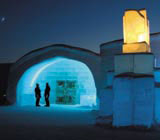Cold front
Sadie Briggs chills out at the Absolut Icebar in Milan, a monument to the Swedish vodka brand, and meets its Italian designer, Alessandro Rosso

First, the entire bar is housed inside a 100m2 freezing room. An engine at the bar has the capacity to reduce the temperature of this room to -30° in the space of an hour, and the bar is constantly monitored through a security system hooked up to the Internet, triggering an alarm in Sweden should anything go wrong. In the worst case scenario a Swedish engineer can get to the Town House site within two hours.
The 30-50 tonnes of ice destined for Milan were transported by trailer and boat from Jukkasjärvi, and most pieces were sculpted on-site there first. Ice sculpting requires particular techniques, including a laser to create the Icebar logotypes. Everything else is created by hand. ‘Ice-tools’, like rounded flints, have been developed over years of re-building the Icehotel. Bergh describes them as ‘razor-sharp chisels’ used to fine-tune the material after rough sculpting.
Although larger than the Swedish Icebar, the Milan bar will only accommodate 50-60 people at a time, for half an hour each. It’s just enough time for a couple of vodka shots. In Stockholm, the pilot project at the Nordic Sea design hotel hosted more than 70 000 guests in its first year. Now in its second year, more than 100 000 have already visited.
There is real respect for ice within the in-house creative team at Icehotel. Agnetha Lund, director of Icebar International, explains that the original Icehotel was first created ‘on the ice. The river [at Jukkasjärvi] just stops for six months, and then flows into the Baltic Sea’. All the ice used in Milan comes from this river, the Torne. Its high speed flow during the freezing process creates crystal-clear material. But to prevent people slipping on the bar floor, white, broken stones from the river have been layered over the frozen base. It’s the only element not made from ice.
Lund says it is a unique experience. The material begs interaction. Customers’ ice-glasses are theirs to keep (if they can), as their lips leave a personal imprint. Likewise, Icebar is replaced as customers slowly wear it away and it loses its cut-glass, sparkling edge.
-
Post a comment




